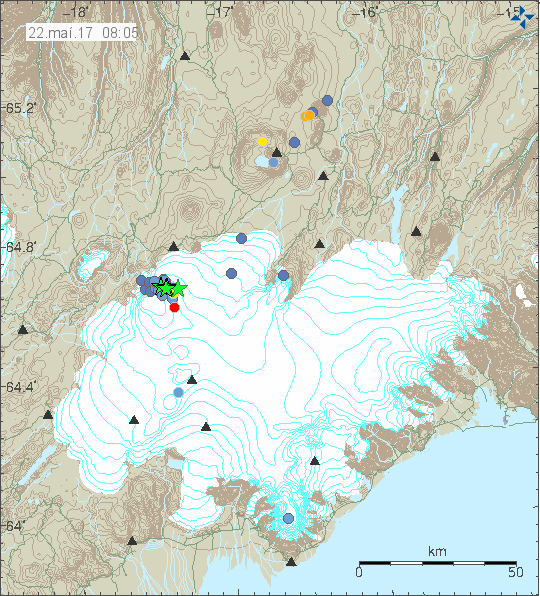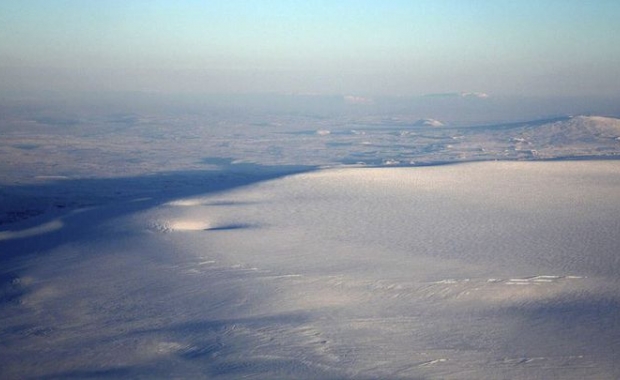A sharp earthquake swarm, including four powerful earthquakes hit Bárðarbunga caldera during the weekend. The first quake, a 3.8 magnitude quake was detected at 20:32 on Saturday evening, followed by three other powerful quakes and a swarm of nearly two dozen smaller quakes. The quakes were in the North Eastern part of the caldera
Read more: Quick primer on Bárðarbunga, Iceland's most powerful volcano

The Icelandic Meteorological Office detected the first tremor, a 3.8 magnitude quake at a depth of 7.4 km (4.4 mi), at 20:32. This first quake was quickly followed by two other powerful quakes in the same part of the caldera, but at different depths. First a a powerful 3.9 magnitude tremor at a depth of 8.9 km (5 mi.), followed by a second somewhat less powerful 3.2 magnitude quake closer to the surface. The epicenter of this quake was at a depth of 1.1 km (0.6 mi.).
These initial quakes were succeeded by a swarm of smaller quakes, most of which originated at significant depths beneath the caldera, 5-10 km (3.1-6.2 mi.) beneath the surface. A fourth powerful quake then hit the caldera at 21:15, also at a depth of 7.8 km. (4.3 mi.).
Read more: All of Iceland‘s major volcanoes showing unusually high levels of activity
The IMO has been recording significant activity in the monster volcano in recent months. These swarms have taken place in all parts of the caldera, but at varying depths. The quakes are caused by the magma chambers of Bárðarbunga are filling up again after the 2014 Holuhraun eruption. The Bárðarbunga volcano has generated some of the largest and most powerful volcanic eruptions in Icelandic history. Historically the Bárðarbunga system erupts in drawn out episodes with several eruptions separated by periods of intense seismic activity.
A sharp earthquake swarm, including four powerful earthquakes hit Bárðarbunga caldera during the weekend. The first quake, a 3.8 magnitude quake was detected at 20:32 on Saturday evening, followed by three other powerful quakes and a swarm of nearly two dozen smaller quakes. The quakes were in the North Eastern part of the caldera
Read more: Quick primer on Bárðarbunga, Iceland's most powerful volcano

The Icelandic Meteorological Office detected the first tremor, a 3.8 magnitude quake at a depth of 7.4 km (4.4 mi), at 20:32. This first quake was quickly followed by two other powerful quakes in the same part of the caldera, but at different depths. First a a powerful 3.9 magnitude tremor at a depth of 8.9 km (5 mi.), followed by a second somewhat less powerful 3.2 magnitude quake closer to the surface. The epicenter of this quake was at a depth of 1.1 km (0.6 mi.).
These initial quakes were succeeded by a swarm of smaller quakes, most of which originated at significant depths beneath the caldera, 5-10 km (3.1-6.2 mi.) beneath the surface. A fourth powerful quake then hit the caldera at 21:15, also at a depth of 7.8 km. (4.3 mi.).
Read more: All of Iceland‘s major volcanoes showing unusually high levels of activity
The IMO has been recording significant activity in the monster volcano in recent months. These swarms have taken place in all parts of the caldera, but at varying depths. The quakes are caused by the magma chambers of Bárðarbunga are filling up again after the 2014 Holuhraun eruption. The Bárðarbunga volcano has generated some of the largest and most powerful volcanic eruptions in Icelandic history. Historically the Bárðarbunga system erupts in drawn out episodes with several eruptions separated by periods of intense seismic activity.







